Exploring Kenya’s Culinary Delights: A Journey Through 10 Must-Try Foods
Embark on a culinary adventure through Kenya, where vibrant flavors and diverse ingredients await. From hearty staples like Ugali and Nyama Choma to savory delights such as Sukuma Wiki and Chapati, discover the essence of Kenyan cuisine in these ten must-try dishes. Join us as we explore the rich tapestry of flavors that define this East African culinary experience.
1.Ugali
Ugali is a staple food in Kenya, deeply embedded in the country’s culinary traditions and cultural heritage. Made from maize flour (cornmeal) and water, it is a simple yet highly versatile dish enjoyed by people from all walks of life.
The process of making ugali is straightforward. Water is brought to a boil in a large pot, and maize flour is gradually added to the boiling water while stirring continuously. The mixture is stirred consistently to avoid lumps, eventually forming a thick, dough-like consistency. Once it reaches the desired thickness, the heat is reduced, and the ugali is allowed to cook through for a few more minutes. The cooked ugali is then shaped into a round or oval mound and served hot.
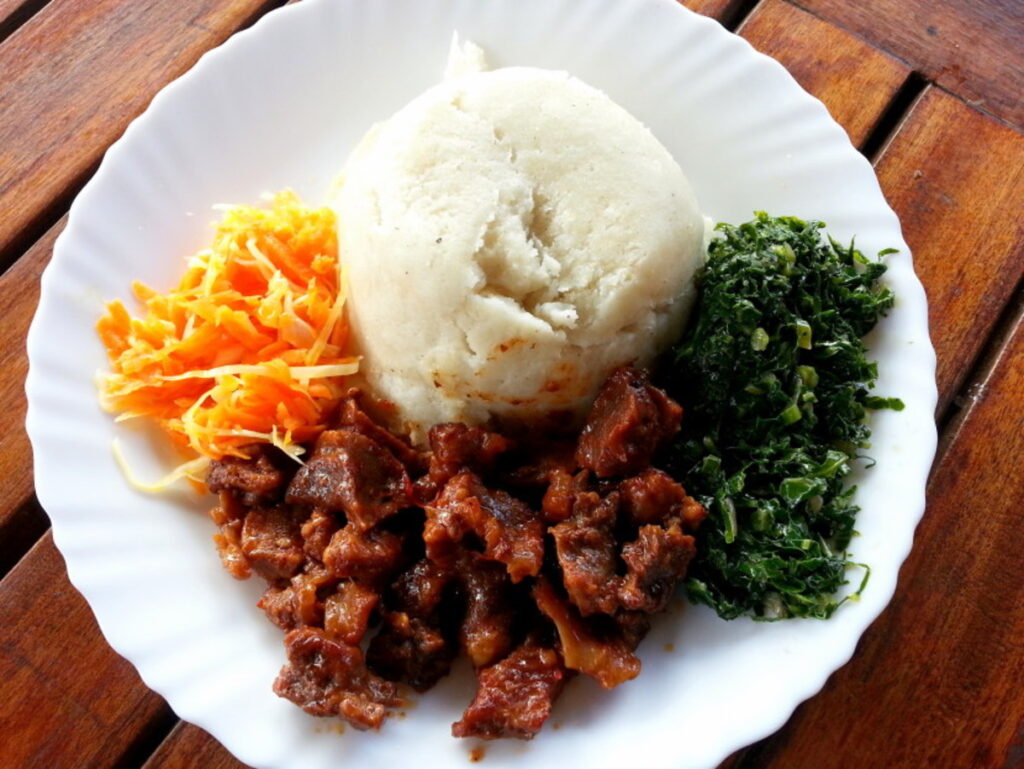
Ugali holds a central place in Kenyan culture for several reasons. It is a daily dietary staple for many Kenyans, providing a reliable source of carbohydrates and energy. Ugali is often a symbol of unity and community, bringing families together during meals. It is commonly shared among family members and guests. Its mild flavor and dense texture make it an excellent accompaniment to a variety of flavorful dishes.
Ugali’s versatility pairs well with various side dishes, including vegetables like sukuma wiki, spinach, and cabbage, often sautéed with onions, tomatoes, and spices. It is commonly served with meaty stews made from beef, goat, chicken, or fish. These stews are typically rich and well-seasoned, complementing the plainness of ugali. Beans, lentils, and other legumes are frequently cooked in savory sauces and served alongside ugali, providing protein and additional nutrients.
Ugali is valued for its nutritional benefits. As a carbohydrate-rich food, ugali provides a significant source of energy. Its dense texture makes it filling, which is especially important in regions where food scarcity can be an issue. While primarily a source of carbs, ugali can be part of a balanced diet when paired with protein-rich and vegetable side dishes.
While the basic recipe for ugali is consistent across Kenya, there are regional variations in how it is prepared and served. In regions like Western Kenya, ugali may be made with a mixture of maize flour and sorghum or millet flour, giving it a slightly different flavor and texture. In coastal areas, coconut milk might be added to the ugali, providing a unique twist.
Ugali is more than just food in Kenya; it is a cultural cornerstone that plays a vital role in the daily lives of many Kenyans. Its simplicity, versatility, and the sense of community it fosters make it an enduring symbol of Kenyan cuisine and culture. Whether enjoyed with a simple vegetable dish or a hearty stew, ugali remains a beloved and essential part of Kenya’s culinary heritage.
2.Nyama Choma
Nyama Choma is a quintessential Kenyan dish that translates to “grilled meat.” It is a beloved culinary tradition and a social activity that brings people together to enjoy food and fellowship. Nyama Choma typically involves grilling beef, goat, or lamb, seasoned simply with salt or marinated with various spices to enhance its flavor.
The preparation of Nyama Choma begins with selecting the meat, often opting for high-quality cuts that are tender and flavorful. The meat is then marinated or simply seasoned with salt, allowing the natural flavors to shine through during the grilling process. In some regions, additional spices and marinades, such as garlic, ginger, and local herbs, are used to infuse the meat with a rich taste.
The grilling is usually done over an open flame or charcoal, which imparts a smoky flavor to the meat. The cooking process is monitored closely to ensure that the meat is cooked to perfection, achieving a balance of a crispy exterior and a juicy interior. The result is a succulent, flavorful dish that is often served with various accompaniments.
Nyama Choma is typically accompanied by side dishes that complement the rich, smoky flavor of the meat. Common accompaniments include kachumbari, a fresh tomato and onion salad; ugali, a maize flour staple; and sukuma wiki, sautéed collard greens. These side dishes provide a balanced meal, adding freshness, texture, and nutritional value.
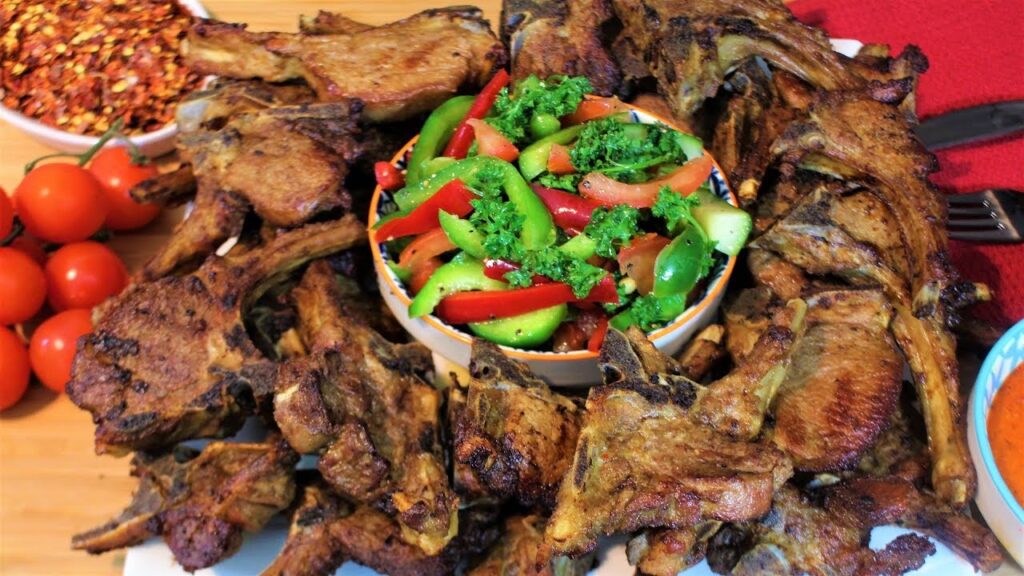
The cultural significance of Nyama Choma extends beyond its culinary appeal. It is a social event, often enjoyed during gatherings, celebrations, and communal events. Friends and family come together to share the meal, engaging in lively conversations and enjoying the communal atmosphere. Nyama Choma joints, or local eateries specializing in grilled meat, are popular spots for socializing and enjoying this iconic dish.
Nyama Choma also holds a place in the broader East African region, with variations and similar practices found in neighboring countries like Tanzania and Uganda. However, it remains uniquely Kenyan in its style and cultural context.
Nyama Choma is more than just a dish in Kenya; it is a cultural experience that embodies the spirit of community and togetherness. The simple yet flavorful preparation, the communal enjoyment, and the cultural significance make Nyama Choma a cherished part of Kenyan heritage. Whether enjoyed at a local joint or prepared at home for a special occasion, Nyama Choma continues to be a symbol of Kenyan culinary pride and social tradition.
3.Sukuma Wiki
Sukuma Wiki is a popular Kenyan dish made from collard greens, known for its simplicity, versatility, and nutritional benefits. The name “sukuma wiki” translates to “push the week” in Swahili, highlighting its role in extending meals due to its affordability.
To prepare Sukuma Wiki, collard greens are washed, chopped, and cooked with sautéed onions, tomatoes, and garlic. Sometimes additional spices like cumin or chili are added. The dish is seasoned with salt and occasionally lemon juice for added brightness. Sukuma Wiki is often served with ugali, a maize flour staple, but it also pairs well with Nyama Choma, rice, and chapati.
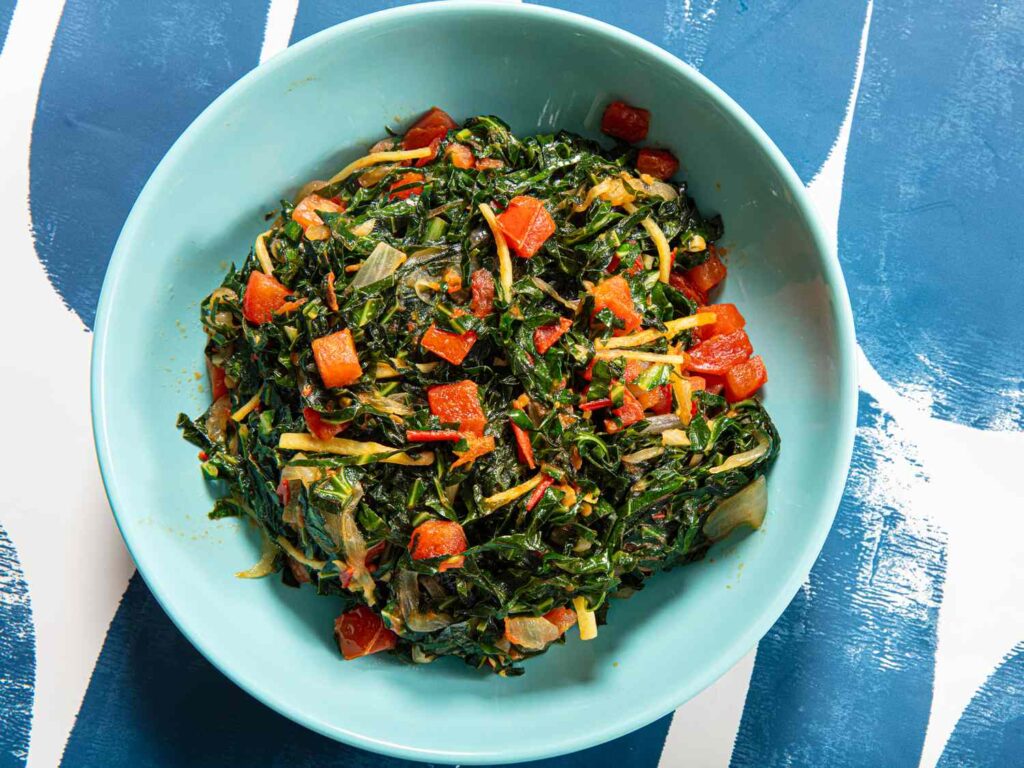
Nutritionally, Sukuma Wiki is rich in vitamins A, C, and K, as well as calcium, iron, and dietary fiber. These nutrients support immune function, bone health, and digestion. Its affordability and nutritional value make it essential in many Kenyan diets, especially during economic hardships.
Culturally, Sukuma Wiki is significant in Kenyan households for its cost-effectiveness and ease of preparation. It is commonly sold in markets and roadside stalls and is a staple in Kenyan restaurants, offering a taste of home-cooked comfort.
Sukuma Wiki is a symbol of resilience and nutritional sustenance in Kenyan cuisine. Its simple preparation, versatile pairings, and health benefits make it a cherished part of daily life and culinary tradition in Kenya.
4.Chapati
Chapati is a beloved flatbread in Kenyan cuisine, enjoyed for its versatility, simplicity, and delightful taste. Originally of Indian origin, chapati has been seamlessly integrated into Kenyan culinary traditions, becoming a staple in many households.
The preparation of chapati involves a straightforward process. Flour, water, salt, and a bit of oil or ghee are mixed to form a dough. This dough is kneaded until smooth, then allowed to rest. After resting, the dough is divided into small balls, rolled out into thin circles, and cooked on a hot skillet or griddle. Each chapati is cooked until golden brown on both sides, often brushed with oil or ghee during cooking to enhance its flavor and texture.

Chapati is incredibly versatile and pairs well with a variety of dishes. It is commonly served with stews such as beef, chicken, or lentils, providing a perfect vehicle for soaking up rich sauces. It also complements vegetable dishes like sukuma wiki, adding a satisfying element to the meal. Additionally, chapati can be enjoyed with breakfast foods, rolled up with tea, or used to scoop up curries and other flavorful dishes.
Nutritionally, chapati is a good source of carbohydrates and provides some protein and dietary fiber, especially when made with whole wheat flour. It offers a filling and energy-boosting component to meals, making it a popular choice for both everyday meals and special occasions.
Culturally, chapati holds a special place in Kenyan cuisine. It is often made during festive seasons, family gatherings, and celebrations, symbolizing warmth and hospitality. The process of making chapati is often a communal activity, bringing family members together in the kitchen.
In urban and rural areas alike, chapati is a common sight in homes, markets, and eateries. It is cherished not only for its taste but also for the sense of community and tradition it fosters.
Chapati is a cherished flatbread in Kenya, appreciated for its ease of preparation, versatility, and role in bringing people together. Whether enjoyed with savory stews, vegetable dishes, or on its own, chapati remains a beloved staple in Kenyan cuisine, embodying the warmth and richness of the country’s culinary heritage.
5.Githeri
Githeri is a traditional Kenyan dish made from a simple yet hearty combination of boiled maize (corn) and beans. It is a staple food among many communities in Kenya, known for its nutritional value, ease of preparation, and cultural significance.
The preparation of githeri involves boiling dried maize and beans together until they are tender. This basic mixture can be enhanced with a variety of ingredients to add flavor and nutritional value. Common additions include onions, tomatoes, potatoes, carrots, and green vegetables like spinach or kale. The dish is often seasoned with salt and occasionally spiced with chili, garlic, or curry powder to create a more flavorful meal.
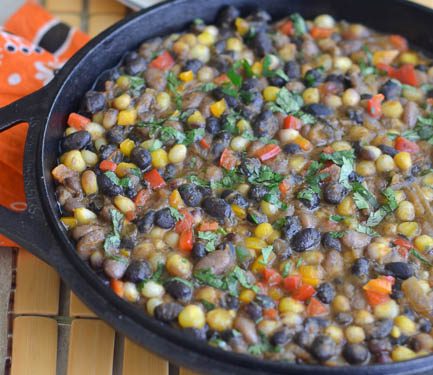
Githeri is typically served as a main dish due to its substantial and filling nature. It can be enjoyed on its own or paired with sides such as chapati, rice, or ugali. The versatility of githeri allows it to be adapted to different tastes and preferences, making it a beloved dish across various regions in Kenya.
Nutritionally, githeri is highly valued for its balance of protein, carbohydrates, and fiber. The beans provide protein and essential amino acids, while the maize offers carbohydrates for energy. The inclusion of vegetables adds vitamins and minerals, making githeri a well-rounded and wholesome meal.
Culturally, githeri holds a special place in Kenyan society. It is often associated with communal activities and traditional ceremonies. In many rural areas, githeri is a staple food prepared in large quantities to feed families and communities, especially during harvest seasons and festive occasions. Its simplicity and the use of locally available ingredients make it an accessible and economical option for many households.
In urban areas, githeri has found its way into schools, workplaces, and restaurants, reflecting its widespread appeal and adaptability. It is commonly prepared in large batches and sold as a convenient and nutritious street food, catering to the busy lifestyles of city dwellers.
Githeri is a cherished Kenyan dish known for its simplicity, nutritional value, and cultural significance. Whether enjoyed at home, at communal gatherings, or as a quick meal on the go, githeri remains a beloved part of Kenyan cuisine, symbolizing sustenance, community, and tradition.
6.Mukimo
Mukimo is a traditional Kenyan dish that originates from the Kikuyu community but has gained popularity across the country. It is a flavorful and nutritious dish made by mashing a combination of boiled potatoes, green peas, maize (corn), and pumpkin leaves or spinach. Sometimes, beans and other vegetables are added to enhance its nutritional value and taste.
The preparation of mukimo involves several steps:
- Boiling: Potatoes, green peas, maize, and pumpkin leaves or spinach are boiled until tender.
- Mashing: Once cooked, the ingredients are mashed together to form a smooth, thick mixture. Some variations may include sautéing onions and mixing them into the mash for added flavor.
- Seasoning: The dish is seasoned with salt, and sometimes additional spices like pepper or curry powder are added, depending on regional preferences.
Mukimo is typically served as a main dish or a side dish and pairs well with various meats and stews. Common accompaniments include nyama choma (grilled meat), chicken stew, beef stew, or fish. The dish’s mild flavor complements the rich, savory taste of these protein dishes, creating a balanced meal.
Nutritionally, mukimo is highly valued for its health benefits. The combination of potatoes, peas, and maize provides a good balance of carbohydrates, protein, and fiber. The inclusion of green leafy vegetables like pumpkin leaves or spinach adds essential vitamins and minerals, making mukimo a wholesome and nutritious dish.

Culturally, mukimo holds a special place in Kenyan cuisine, especially among the Kikuyu community. It is often prepared during special occasions such as weddings, festivals, and communal gatherings. The dish symbolizes unity and sharing, as it is commonly made in large quantities to feed many people.
In urban areas, mukimo has become a popular dish in restaurants and homes, reflecting its versatility and widespread appeal. It is also a common sight at Kenyan celebrations and events, where it is enjoyed by people from diverse backgrounds.
Mukimo is a beloved Kenyan dish known for its simplicity, nutritional value, and cultural significance. Its preparation involves mashing together potatoes, peas, maize, and leafy greens to create a flavorful and nutritious meal. Whether served as a main dish or a side, mukimo remains a cherished part of Kenyan cuisine, embodying the principles of unity, community, and tradition.
7.Samosas
Samosas are a popular snack in Kenya, known for their crispy texture and savory fillings. Originally from India, samosas have become deeply ingrained in Kenyan cuisine, adapting to local tastes and preferences.
The preparation involves making a thin pastry dough, filling it with a savory mixture typically made of spiced minced meat (such as beef or chicken), potatoes, peas, onions, garlic, ginger, and a variety of spices like cumin and coriander. The filled dough is folded into a triangular shape and then deep-fried until golden and crispy.
Samosas are enjoyed hot and are often served with chutneys, sauces, or fresh salads like kachumbari. They are popular as snacks, appetizers, or as part of a larger meal.

Nutritionally, samosas provide carbohydrates and proteins from their fillings, along with some vitamins and fiber from vegetables. However, due to deep-frying, they are high in calories and fat, making them best enjoyed in moderation.
Culturally, samosas hold a significant place in Kenyan society. They are widely available in markets, roadside stalls, and homes, and are particularly favored during celebrations and social gatherings. Samosas symbolize hospitality and are commonly offered to guests as a gesture of welcome and generosity.
Samosas are a cherished part of Kenyan culinary tradition, offering a delicious combination of flavors and textures that appeal to a wide audience. Whether enjoyed as a quick snack or part of a festive meal, samosas continue to be a beloved symbol of flavor and community in Kenya.
8.Madras
Madras curry, often referred to simply as “Madras,” is a popular curry dish that originates from the South Indian city of Madras (now Chennai). It has also become well-known and adapted in various forms in Kenyan cuisine, influenced by Indian culinary traditions brought over by immigrants.
Madras curry is characterized by its rich, reddish-brown color and robust flavor profile. The dish typically features a blend of spices that may include coriander, cumin, turmeric, chili powder, fenugreek, and sometimes mustard seeds. These spices are combined with onions, tomatoes, garlic, and ginger to create a flavorful base.
Meat or vegetables are then added to the spice mixture, creating a hearty curry dish. Common meats used include chicken, lamb, or beef, while vegetarian options may include potatoes, chickpeas, or mixed vegetables. Coconut milk or yogurt is sometimes added to enhance the creaminess of the sauce and balance the spiciness.

In Kenyan cuisine, Madras curry is often served with rice or chapati, making for a satisfying and flavorful meal. It has adapted to local tastes and ingredients, resulting in variations that reflect Kenya’s diverse culinary landscape. The dish’s versatility and bold flavors have made it a favorite in both home kitchens and restaurants across the country.
Overall, Madras curry is a testament to the cultural exchange and influence of Indian cuisine in Kenya, offering a delicious blend of spices and ingredients that have found a special place in the hearts and palates of many Kenyans.
9.Kenyan Chai
Kenyan Chai, known simply as Kenyan tea, is a beloved beverage that holds a special cultural significance in Kenya. Unlike the familiar Indian “chai,” Kenyan chai specifically refers to a strong, milky tea enjoyed throughout the country.
Preparation involves boiling black tea leaves from regions like Kericho or Nandi Hills. Once brewed, the tea is mixed with hot milk and sweetened with sugar to create a creamy, sweetened beverage. Some variations may include spices like ginger or cardamom for added flavor complexity.

Kenyan chai is traditionally served hot in small glasses or cups. It is a staple in homes, workplaces, and local cafes, where it is enjoyed throughout the day. The ritual of preparing and sharing chai fosters social interactions, symbolizing hospitality and community.
Overall, Kenyan chai is more than just a drink; it is a cultural ritual that brings people together, offering comfort and warmth in both everyday life and special occasions. Its rich flavor and creamy texture embody the vibrant spirit of Kenyan hospitality and culinary tradition.
10.Pilau
Pilau is a popular dish in Kenyan cuisine, renowned for its rich flavors and aromatic spices. It is a fragrant rice dish cooked with meat (often chicken, beef, or goat), vegetables, and a blend of spices that give it its distinctive taste.
The preparation of pilau typically involves frying onions until golden brown, then adding meat and spices such as cumin, cinnamon, cloves, cardamom, and black pepper. The meat is browned and cooked until tender, infusing the spices into the dish. Rice is then added to the mixture, along with water or broth, and cooked until fluffy and infused with the flavors of the spices and meat.
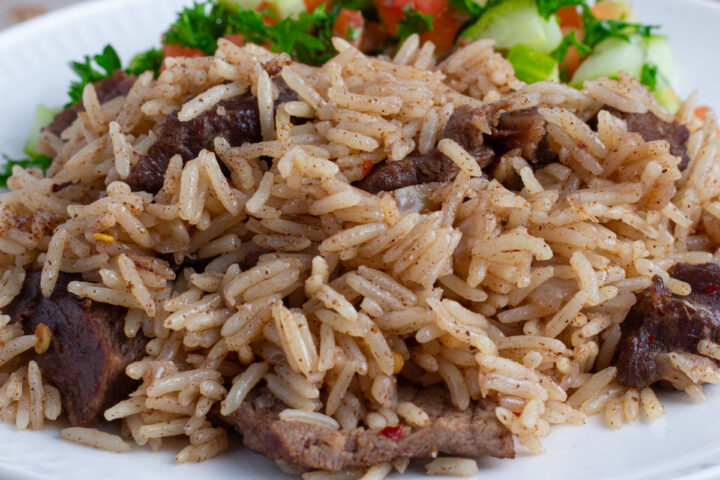
Pilau is often served as a main dish at weddings, celebrations, and festive gatherings. It is accompanied by side dishes like kachumbari (tomato and onion salad), raita (yogurt with cucumber and mint), or a variety of chutneys. Its popularity in Kenya reflects its versatility, as it can be adapted with different meats or made vegetarian by using beans or peas instead.
Culturally, pilau holds a special place in Kenyan culinary traditions, symbolizing hospitality and communal sharing. Its preparation varies regionally and among different communities, with each adding their unique twist to the recipe. Pilau continues to be a beloved dish that brings people together over its delicious flavors and communal spirit.
Also Read on 10 MOST BEAUTIFUL & INTERESTING PLACES TO VISIT IN KENYA


